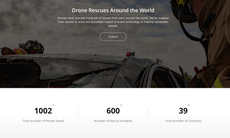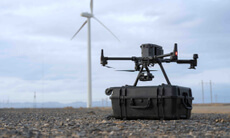
Ever since the U.S. National Transportation Safety Board effectively legalized commercial use of unmanned aircraft in 2014, instant aerial data from drones have been transforming industrial applications in whole new ways. The ability to automatically process raw aerial images from multiple perspectives into meaningful data for analysis and on-the-spot decision-making has been a game-changer in a number of industries. At the forefront of this commercial drone data “revolution” is the oil and gas industry.
In Cushing, Oklahoma—the oil crossroads of the world—construction contractors like Aerial Data Service, Inc. used to hire helicopters to fly over oil tank construction sites for visual inspection. These helicopter flights were not only notoriously expensive, but also only provided a handful of images from a few limited angles. But through a new partnership with Hover Visions drone photography and video services, Aerial Data Service, Inc. is now able to use the DroneDeploy Android app to easily plan and automatically fly a DJI Inspire 1 to capture and instantly process all the required aerial images. In fact, their first Inspire 1 flight only took 15 minutes to cover an entire 18 acre storage tank construction site.
“Drones offer all sorts of applications that the industry can use. They can allow oil and gas companies to monitor pipelines, roads, storage tanks, buildings, bridges, and power lines, and also provide a critical role in response to oil spills.”
These potential business opportunities with drones have also prompted the world’s largest oil and gas companies to adopt the technology in ways never before imagined.
After seeing one of the first 3-D models produced by a drone in Prudhoe Bay, BP officials were impressed. “That’s more data in 45 minutes than we’ve gotten in the last 30 years,” Curtis Smith, a technology director with BP, said in a 2014 interview with The Wall Street Journal. “It’s revolutionary.”
But the advantages of using commercial drone data for real-time monitoring, 3D modeling and analysis are not limited to the oil and gas industry. In fact, just about any industry that currently relies on visual inspection in dangerous environments stands to benefit.
"Oil and gas is a big vertical, but the same technology applies to lots of industries — wind farms, solar, other refineries, pipelines and other fixed infrastructure," says Simon Menashy, investment director at venture capital firm MMC Ventures, which invested $4 million in Sky Futures [UAV inspection services] in May. That's before even looking at construction and agriculture. "There is lots of opportunity," he adds.
—Flying Robots Replace Oil Roughnecks (Bloomberg Business)
Indeed, even the U.S. Secretary of Transportation, Anthony Foxx, has recognized the importance and growing opportunities of expanding commercial drone use:
"These surveys on Alaska’s North Slope are another important step toward broader commercial use of unmanned aircraft. The technology is quickly changing, and the opportunities are growing."
—Oil Giant BP Is First Company Approved to Use Commercial Drones (Fast Company)
From oil giants like BP to construction contractors like Aerial Data Service, Inc. and Hover Visions, the oil and gas industry has clearly embraced a future where the power of aerial data can be captured, processed and analyzed in an instant, thanks to innovative commercial drone applications like DroneDeploy and more.
For more info about the Inspire 1 UAV used by Hover Visions and Aerial Data Service, Inc. at: www.dji.com/nz/product/inspire-1
To find out how you can develop your own customized aerial platform application, head over to: developer.dji.com
Learn more about instant aerial data at dronedeploy.com and start mapping for free!


